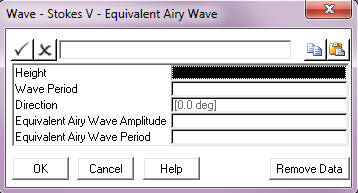Of the 21 Wave Type options, 7 relate to regular waves. PipeLay has 3 regular wave options, namely linear or Airy waves, Stokes V waves and Dean’s Stream Function waves. The program options under these 3 headings are now outlined.
You can include one or multiple regular Airy waves, with each wave having a separate amplitude, period, direction and phase relative to a common datum, in your dynamic runs. The dialog for defining Regular Airy waves is shown in the figure below.

Regular Airy Wave(s)
This dialog is straight-forward in its operation - you simply use one line for each wave harmonic you want to input. Obviously, for a single regular wave, you specify one line of data.
There are three options for including a Stokes V wave in an analysis. In the PipeLay terminology these are:
▪ Stokes V
▪Stokes V – Superposition of Harmonics
These differ only in how the program calculates the vessel response to the Stokes V wave when that response is defined in terms of RAOs. For all three options, the water surface elevation and the wave loading on the structure, for a given wave height and period, is identical.
When you choose either Stokes V or Stokes V – Superposition of Harmonics, clicking on the Wave Data button brings up a dialog for the specification of a wave height, a wave period and a wave direction, measured in degrees anti-clockwise from the global Y-direction. The wave direction defaults to 0°, but non-zero inputs are required for the other two. The figure below shows the Wave Data dialog for the Stokes V case.

Stokes V Wave
The data for the Stokes V – Equivalent Airy Wave is shown in the figure below. Here there are two additional entries, an equivalent Airy wave amplitude and period. These define an Airy wave that is used with your vessel RAOs to calculate a first-order vessel response to the (fifth-order) Stokes V wave. If you choose this option, you must specify a non-zero Equivalent Airy Wave Amplitude. Specification of an Equivalent Airy Wave Period is optional; if you don’t input one, the program uses the Stokes V wave period.

Stokes V Wave with Equivalent Airy Wave
The specification of data for a Dean’s Stream Function regular wave is very similar to that for a Stokes V wave. Specifically, the program again has three options, which in the PipeLay terminology are:
▪Dean’s Stream – Multiple Order
▪Dean’s Stream – Equivalent Airy
▪Dean’s Stream – Superposition of Harmonics
Again these three options govern how vessel response to the Dean’s Stream Function wave is calculated, and a detailed discussion of this is provided in Technical Note 6 – Dean’s Stream Function.
The figure below shows the Wave Data dialog for the first and last Dean’s Stream Function options. Wave height, period and direction have the usual meanings here. The Eulerian Current Velocity is the velocity of the underlying current; this corresponds to the current recorded by a stationary meter. The principal consequence of an underlying current is a Doppler shift of the apparent wave period. The Order of Expansion is essentially a measure of how non-linear a wave is. In deep water the order can be relatively low (between 3 and 5), while in shallow water the order can be as high as 30. PipeLay uses a default of 15. Max Iterations is used to specify the maximum number of iterations to be used in solving the Dean’s Stream function equations. This value defaults to 100. Finally, the Fourier theory formulations used by PipeLay to solve the Dean’s Stream Function equation can occasionally lead to multi-crested solutions, particularly in shallow water. In order to eliminate this, the wave height is gradually increased to the required height in the Number of ramp steps specified here.

Dean’s Stream Function Wave – Multiple Order
The above data inputs are augmented by an Equivalent Airy Wave Amplitude and an Equivalent Airy Wave Period in the case of the Dean’s Stream – Equivalent Airy Wave option. As it is for the Stokes V wave, the amplitude input is mandatory and the period is optional. Again these inputs define an Airy wave which is used with user-defined vessel RAOs to calculate a first-order response to the Dean’s Stream Function wave.
PipeLay uses a version of Dean’s stream function known as Fenton’s Fourier series theory to compute the wave kinematics for a given set of wave parameters. This method eliminates the need to use tabular or graphical presentations of the solutions in order to solve the stream function equation and is an efficient and accurate solution method.